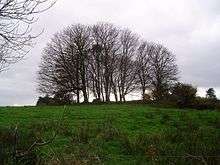Fairy fort
Fairy forts (also known as lios or raths from the Irish, referring to an earthen mound) are the remains of stone circles, ringforts, hillforts, or other circular prehistoric dwellings in Ireland.[1] From (possibly) late Iron Age to early Christian times, the island's occupants built circular structures with earth banks or ditches. These were sometimes topped with wooden palisades and wooden framed buildings. As the dwellings were not durable, in many cases only vague circular marks remain in the landscape.[2] The remains of these structures are sometimes associated with local traditions and folklore, perhaps involving fairies or other supposed supernatural entities, who would "defend" the structures from destruction by builders or farmers.[3]

Interpretation
Tradition claimed that ringforts were "fairy forts" imbued with druids' magic and believers in the fairies did not alter them. The early pre-Celtic inhabitants of Ireland (known as the Tuatha Dé Danann and Fir Bolg) came to be seen as mythical and were associated with stories of fairies, also known as the "Good People". Fairy forts and prehistoric Tumuli were seen as entrances to their world.[4] Even cutting brush, especially the sceach or whitethorn, on fairy forts was reputed to be the death of those who performed the act.[5]
There are many folk tales about supernatural events happening at fairy forts. Real accidents which happened at ringforts could be given supernatural explanations. For example, a man who tried to blast a dolmen suffered a septic hand. The wrecked dolmen was subsequently left untouched.[6]
Other traditions hold that a leprechaun may allegedly know of hidden gold in a fairy fort.[7]
In literature, British author Rudyard Kipling made allusions to the process by which such legends grow in his 1906 novel, Puck of Pook's Hill.[8]
Folk tales
Folk tales associated with "fairy fort"s typically relate a curse or retribution enacted upon those who would disturb or destroy the structures. For example, one story, suggests that a man who had engaged workmen to level an earthwork fairy fort at Dooneeva (County Clare) simply fell dead. His wife, a "white witch" reputedly brought him back to life magically.[9]
Other folk tales relate to the taking of farm animals or people (typically women or children) by the reputed occupants of fairy forts.[10][11]
As recently as 2011, the financial ruin of developer Seán Quinn was blamed on his moving a fairy fort.[12] And, in 2017, a Kerry politician reputedly suggested that an instance of road subsidence had been caused by the presence of fairy forts locally.[13]
See also
References
- "Fairy Forts, Music, & Language of Ireland". www.romanceeverafter.com. Archived from the original on 16 June 2007.
- "The Celts & Celtic Ireland". Archived from the original on 7 December 2006.
- "Fairy forts: Why these 'sacred places' deserve our respect". irishtimes.com. Irish Times. 9 August 2017. Retrieved 19 May 2020.
- "An Other World". The British Council, Poland. 2004. Archived from the original on 25 April 2007.
- Eddie Lenihan and Carolyn Eve Green, Meeting The Other Crowd: The Fairy Stories of Hidden Ireland, p 125 ISBN 1-58542-206-1
- "A Folklore Survey of County Clare: Fairies and Fairy Forts and Mounds". Clarelibrary.ie. Retrieved 13 March 2014.
- "THE LEPRECHAUN". Ethnic Dolls From Around The World - National and Regional Costumes. Retrieved 13 March 2014.
- Rudyard Kipling. "Puck of Pook's Hill". www.gutenberg.org.
- "A Folklore Survey of County Clare: Fairies and Fairy Forts and Mounds". www.clarelibrary.ie.
- "Tales of Fairies and the Ghost World: Fairy Cows". www.sacred-texts.com.
- "Readings". canvas.wisc.edu. Retrieved 23 October 2018.
- Greg Harkin (4 December 2012). "Sean Quinn's downfall is fairies' revenge say locals in Cavan". Independent.ie. Retrieved 13 March 2014.
- "Danny Healy-Rae claims fairy forts caused dip in Kerry road". irishtimes.com. Irish Times. 8 August 2017. Retrieved 19 May 2020.